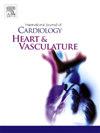Combining D-dimer and LDL/HDL ratio to predict the absence of atrial fibrillation in patients with an Implantable Loop Recorder for embolic stroke of Undetermined source
IF 2.5
Q2 CARDIAC & CARDIOVASCULAR SYSTEMS
引用次数: 0
Abstract
Background and Objective
Embolic stroke of undetermined source (ESUS) patients undergoing long-term rhythm monitoring with Implantable Loop Recorder (ILR) have an atrial fibrillation (AF) detection rate of approximately 12 % at 1 year and 30 % with extended follow-up over 3 years. However, research specifically focusing on the majority of patients in whom AF is not detected through implantable cardiac monitors remains limited. Abnormal lipid profiles may be associated with embolic risks from non-AF sources. This study aimed to develop a model to predict the absence of AF in patients with ESUS using multiple variables, including lipid profiles.
Methods
A retrospective, multicenter cohort study was conducted across four institutions, involving 99 ESUS patients. Patients were categorized based on AF detection via ILR. Patient characteristics, blood test results, and echocardiographic findings were assessed through univariate and multivariate logistic regression analyses. ROC curve analysis was performed to evaluate the biomarkers’ predictive accuracy.
Results
AF was detected in 30.3 % of patients over a median follow-up of 25.5 months. Multivariate analysis confirmed elevated D-dimer (OR: 2.77, p = 0.002), low LDL/HDL ratio (OR: 2.0, p = 0.01), and CHA2DS2-VASc score (OR: 1.4, p = 0.04) as independent predictors of AF detection. The CHA2DS2-VASc score was excluded due to multicollinearity, and patients with D-dimer < 0.9 μg/ml and LDL/HDL ratio > 1.98 had significantly lower AF detection rates (6.8 %, P < 0.001; sensitivity 93.1 %, specificity 44.2 %).
Conclusion
Combining D-dimer and LDL/HDL ratios provides an effective and accessible method for predicting the absence of AF in patients with an ILR for ESUS.

求助全文
约1分钟内获得全文
求助全文
来源期刊

IJC Heart and Vasculature
Medicine-Cardiology and Cardiovascular Medicine
CiteScore
4.90
自引率
10.30%
发文量
216
审稿时长
56 days
期刊介绍:
IJC Heart & Vasculature is an online-only, open-access journal dedicated to publishing original articles and reviews (also Editorials and Letters to the Editor) which report on structural and functional cardiovascular pathology, with an emphasis on imaging and disease pathophysiology. Articles must be authentic, educational, clinically relevant, and original in their content and scientific approach. IJC Heart & Vasculature requires the highest standards of scientific integrity in order to promote reliable, reproducible and verifiable research findings. All authors are advised to consult the Principles of Ethical Publishing in the International Journal of Cardiology before submitting a manuscript. Submission of a manuscript to this journal gives the publisher the right to publish that paper if it is accepted. Manuscripts may be edited to improve clarity and expression.
 求助内容:
求助内容: 应助结果提醒方式:
应助结果提醒方式:


